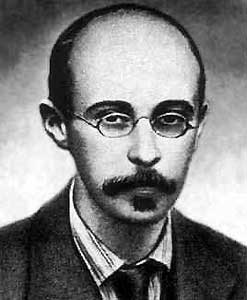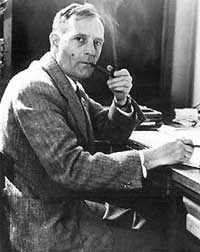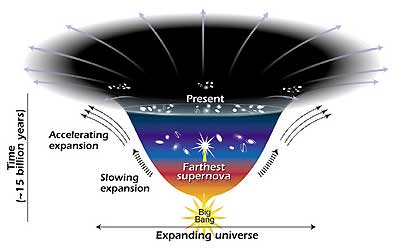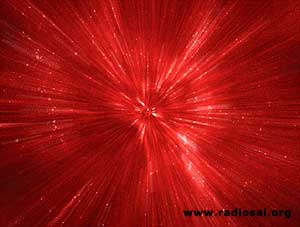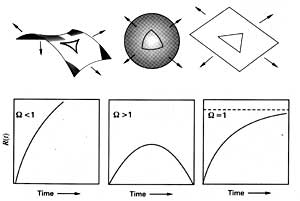 |
 |
 |
Volume
5 - Issue 02 FEBRUARY 2007
|
|
MUSINGS from prasanthi nilayam IN QUEST OF INFINITY - PART two By Prof G. Venkataraman How it all Began Sai Ram and warm greetings again. I am happy to resume with you our joint quest for Infinity! Last time, I gave you a brief glimpse of the Universe we live in and how man, without moving out too much, mostly by gazing, wondering and thinking, combined with a lot of ingenuity of course, has assembled so much information about the Universe. In this issue, I would like to tell you something about what we know about the birth of the Universe.From ‘Steady State’ to ‘Big Bang’
You may not believe, but even as late as the twenties of the 20th Century, people including astronomers thought that the Milky Way in which we are placed, was the only galaxy in the Cosmos, that the Universe always existed, and that the Universe would always be in a steady state, that is, without any change of size. The first half of the twentieth century saw all those concepts give place to something totally different. Most importantly, we now believe that the Physical Universe we live in had a definite birth, an event that is popularly referred to as the Big Bang. The idea of the Big Bang is in some measure due to George Gamow. It must be said that Gamow did not actually ask questions about the birth of our Universe. He was more interested in the question: “How did the very first elements form in the cosmic cauldron that came into existence after the birth of the Universe?” Although people had considered models relating to the Universe earlier, the question of the actual birth of the Universe did not acquire importance till Gamow got into the act. However, the earlier story is interesting in its own way, and maybe I should give a glimpse of it, before I get back to Gamow and the trigger he provided. The Gravity of Einstein’s Theory
Cut to the year 1915, when Einstein, already famous and soon to become almost a rock star, developed his Theory of General Relativity and Gravitation. This is a very important development and maybe I should say a few words about it. We all know that it was Newton who first told us that matter attracts matter due to a force called the gravitational force; that a stone falls to the earth when thrown up because of the force of gravity, and that the Earth goes round the Sun and the Moon goes round the Earth because of gravity. But what exactly is this gravity? That was the question that Einstein answered, though not in full, at least in great measure. Einstein’s Theory of General Relativity [GR] is quite complicated; in fact at the time it was developed, very few scientists understood it, let alone ordinary people. However, we are not concerned with the technical details but an interesting story related to GR. The core of GR is a set of equations and fooling around with them, Einstein applied them to the whole of the Universe. And what did he find? Something unbelievable: the Universe had a birth and thereafter expanded. Einstein was shocked and could not believe what his own equations told him. He said to himself, “There is something wrong with my equations. How can the Universe be born? It has always been there; and this expansion business, it is utter nonsense. So, to get the facts right, let me fix my equations so that they tell the truth.” And Einstein “fixed” his equations by adding what he called the Cosmological Constant, and presto, the equations behaved “well”, meaning they did not predict a birth for the Universe nor any expansion. Einstein felt satisfied and relaxed. Today, even schoolboys know that the Universe had a beginning and is expanding all the time, but around 1920, people had a very different idea about the Universe. Some scholars say it was all due to the subtle influence of religion; I do not know about that, but the fact is that in those days, people, including astronomers [!], thought the Milky Way represented the whole of the Universe! Friedman Theory Sheds New Light
The story now develops two parts, one revolving round Alexander Friedman and the other revolving round Edwin Hubble. We shall take them one by one, starting with Friedman in Russia. Friedman was a young man at that time [1922] and became fascinated by Einstein’s Theory of General Relativity. Like Einstein, he too began playing with Einstein’s equations and found that depending upon the circumstance, the Universe could have different histories. These are described separately. But common to all of them was a birth, and expansion [in one model, in the first stages only]. Einstein being the Grand Master, Friedman sent a letter to big man, submitting his results and requesting Einstein to have the paper published in Germany in a leading Physics journal. As I told you earlier, Einstein had already encountered this business of the Universe being born and had dismissed it. So he wrote a short note to Friedman saying that he was all wrong. Young Friedman was disappointed but did not give up. He checked his work all over again and found he had made no mistake whatsoever and that his findings were true. He wrote a second letter to Einstein, pleading that since there was no mistake, his results deserved publication. Einstein was travelling at that time, and in fact, on account of his travels, he missed going to Stockholm to receive the Nobel Prize in December 1922 [those days, they had to travel by ship and the journey took weeks]. So it is but natural that Einstein missed seeing Friedman’s second letter. However, when Einstein returned to Berlin [where he was those days], a Russian scientist named Krukov managed to meet Einstein personally and argue on behalf of Friedman. Thereupon, Einstein studied Friedman’s work, found that there was no mistake in the Russian’s work, and admitted that Friedman’s work shed new light. Edwin Hubble
We now come to the second part of the story, which takes us to America and deals with Hubble. Edwin P. Hubble was born in Missouri, USA in 1889. After earning a B.S degree from the University of Chicago in 1910, Hubble trained to become a lawyer. However, through the influence of friends, he also developed a strong interest in astronomy. After getting his B.S degree, Hubble went to Oxford as a Rhodes Scholar. At Oxford, Hubble showed the world that he was a good athlete too, by becoming an Oxford Blue in athletics. In addition, he also trained as a heavy weight boxer and even defeated champion George Carpentier in an exhibition fight! On return to America in 1913, Hubble was admitted to the Bar in Kentucky. For a while, he practiced as a lawyer. However, his interest in astronomy prevailed, and Hubble got ready to return to Chicago for graduate studies in astronomy. Meanwhile, the First World War intervened, and Hubble enlisted in the U.S Army. He saw action in France, and rose to the rank of a Major. After the war was over, he returned to pursue his interest in astronomy; and thus began a most fruitful career. Hubble was a very keen observer and made many important discoveries. Discovering the Expansion of the Universe By this time, astronomers had shown that the Universe contained billions of galaxies, and in 1924, Hubble developed an important way of measuring the distances of galaxies, especially the distant ones.
His greatest discovery came some years later when he found that galaxies were all moving away from each other, showing that the Universe was actually expanding. Commenting on this, Hubble wrote: "[all this] should furnish a clue as to the exact nature of the Universe. It may then be possible ….. to say if the Universe and space itself is expanding at a rapid rate and in a remarkable manner. And finally, it may be possible to describe the nature of the expansion and to determine the time at which the expansion began – that is to say, the age of the Universe." The idea of the Universe expanding was now clearly established by observation, confirming what Einstein’s equations had predicted earlier. When Einstein learnt of Hubble’s discovery, he regretted trying to fix his equations earlier by introducing the Cosmological Constant, and described that move as his greatest blunder. But you know what? God has ordained that the Cosmological Constant has a place in His Creation, and it is now back in a new Avatar, without disturbing the expanding Universe! Georges Lemaitre Rediscovers Friedman Theory
It often happened in Science in those days, partly I presume because of lack of communications, that many facts were re-discovered independently by many people. Earlier I told you how Friedman in Russia had discovered what Einstein had found earlier, namely that the Universe might have had a beginning. Same story once more, this time the person involved being a Belgian priest named Georges Lemaitre. Born in 1894, Lemaitre attended a Jesuit College and entered in 1911, the University of Louvain to study engineering. When the First World War broke out in 1914, Lemaitre joined the Belgian Army and was decorated for bravery. In 1918, after the war was over, he resumed his university studies but switched from engineering to mathematics and physics. Simultaneously, he also enrolled in courses in philosophy. His ambition was to specialise in physics and metaphysics! In 1923, Lemaitre wrote a thesis on relativity and gravitation and this won for him a scholarship from the Belgian Government, enabling him to travel to Cambridge. There he came into contact with a famous astronomer named Eddington and this spurred his interest in Cosmology. From England, Lemaitre went to America, made the acquaintance of many astronomers there, and spent some time in the famous MIT in Boston. In October 1925 Lemaitre returned to the University of Louvain, where he remained for the rest of his life. By 1920, Lemaitre had become strongly interested in Einstein’s Theory of General Relativity, which he mastered entirely by self-effort. By the mid-twenties, Lemaitre, unaware of the work done in Russia by Friedman, examined critically some earlier work of de Sitter on Cosmology, and derived some new results. He published these in an obscure journal, and not surprisingly, the results went unnoticed. In 1927, there was a big conference on physics held in Brussels [the capital of Belgium] attended by all the bigwigs, including Einstein. Naturally, as a Belgian, Lemaitre was present, and he took the opportunity to catch the attention of Einstein and tell him about his results. The Master’s reaction was cold. He simply said [in French], “Your calculations are correct but your physical insight is abominable.”
In January 1930, there was a meeting of the Royal Astronomical Society in London, during which there was a lot of discussion about Hubble’s new discovery about the expanding Universe. All this was duly reported in the February issue of the journal The Observatory, which Lemaitre read in full. Immediately he dashed off a letter to Eddington reminding him that as early as 1927, he had sent him [Eddington] a paper that predicted an expanding Universe. Eddington then remembered that indeed he had received a copy of a paper but had completely forgotten about it. He now made amends by writing a letter to the journal Nature drawing attention to Lemaitre’s brilliant work three years before. Suddenly, Lemaitre became a celebrity. In May 1931, Lemaitre published in Nature, a paper that ventured to suggest that the Universe was born from an infinitesimal supreme state of matter condensation, the Primeval Atom as Lemaitre called it. The explosion of this Primeval Atom was what later started off the expansion of the Universe. Rather colourfully, Lemaitre referred to this explosion as a “day without yesterday”. Lemaitre’s theory has also been referred to as a “fireworks theory of the beginning”. In some respects, Lemaitre rediscovered what had already been found earlier by Friedman, though perhaps with a bit more physics than just bare Cosmology. No wonder Russians are annoyed with the credit given to Lemaitre, overlooking the claims of their scientist. George Gamow
All this happened before World War II. During the war years, basic science naturally took a back seat but when the war was over, scientists went back to their passion with renewed vigour. It is time to bring George Gamow back into the picture. Gamow, by the way, was a student of Friedman, and he achieved early fame with some brilliant work in radioactivity. In those days, Russia was a tightly-controlled dictatorship. Gamow found the atmosphere too stifling. He and his wife then planned an escape. They purchased a small canoe and hoarded food for months. They then managed to wangle permission for having a holiday on a Black sea port. And one day, they tried to row out of Russia – they had to paddle nearly 250 km and they thought they would be able to do it. But it did not work that way; the canoe was caught in a storm and blown back to the shore, forty eight hours later! The chance to leave Russia came two years later when the Government sent him to Brussels to attend a conference. From there Gamow went to America in 1934, where he stayed for the rest of his life. During the Second World War, Gamow worked on the atom bomb project. After the war, he turned to Physics and began to wonder about the origin of elements in the early Universe. An Infant Universe It was while trying to answer this question, Gamow reasoned that first there must have been an infant Universe. Next, he said that this baby Universe must have been very, very hot. After this he argued that this was the ideal setting for the cosmic cooking of elements; that was Gamow’s line of reasoning. All this happened around 1948 or so. It was only after Gamow’s seminal work that physicists began to accept the notion that the Universe did have a definite birth. Later, thanks to a casual remark by the British astrophysicist Fred Hoyle, the term Big Bang gained currency and came to be associated with the primordial event that signified the birth of the Physical Universe. By the way, Hoyle never believed in the Big Bang himself, and he, in fact, introduced the term somewhat in a sarcastic vein in a popular talk on Science over the BBC; but the name has stuck, and the belief in the concept too!
One important fall-out of Gamow’s conjecture is the following: “OK, the Universe was born in a hot Big Bang. Then a lot of heat must also have been radiated at that time. If so, is there any remnant of that heat still left now?” The basic argument in favour of such a remnant goes as follows: The Baby Universe must have been extremely hot with a temperature in the range of trillions, yes trillions, of degrees! So the radiation emitted at that time must also have had an astronomically high temperature. But since then the Universe has expanded enormously and since expansion always produces cooling, the original radiation too must have cooled down considerably. Gamow’s student estimated that at the present time the radiation surviving from then must have an absolute temperature of about 5 degrees absolute, or - 268 C! For comparison, the lowest temperature recorded on the face of the Earth is about – 60 C. The predictions we are mentioning were made way back in 1948 or so. In 1960, two scientists in America named Arno Penzias and Robert Wilson accidentally discovered this Cosmic Background Radiation that had been predicted on the basis of Gamow’s theory. One may say that Penzias and Wilson actually heard the OM of Creation! And for their [chance] discovery, they later received the Nobel Prize! The discovery of this Cosmic Background radiation was a landmark event in Cosmology for it provided clear evidence that the Universe did originate in a Big Bang. Three Alternative Scenarios Discovered by Alexander Friedman When Friedman worked with Einstein’s equations of General Relativity and applied them to the Universe [tough mathematics one must say!] he found that there were three possible scenarios. They are as sketched below:
In scenario 1, the Universe has a beginning and thereafter expands endlessly. In scenario 2, the Universe is born, expands for some time, and then begins to shrink. Eventually, it disappears in a Big Crunch, even as it was born in Big Bang. In scenario 3, the Universe is born, and then expands. However, with the passage of time, the expansion slows down and after literally infinite time, the Universe has a fixed size. Two questions arise: a) Why three scenarios, and b) which of these actually applies to our Universe? Let us take the first question first. Three scenarios exist depending upon the amount of “matter” contained in the Universe. The issue is a bit complicated and so I shall avoid the technicalities. Let us turn now to question (b). After years of speculation, it would now appear that 95 % or even more, the Universe is headed for scenario 3 described above. Maybe in a subsequent article, I shall add some more comments on this very important issue. I have lots more to tell you but that would have to wait till the next time. By the way, please note that though I am presently dealing with the physical Universe, later we shall go beyond Physics to Meta-Physics and then on to Vedanta and so on. Waiting for us at the end of it all would be the Cosmic Infinity! It’s a long way to go and there are plenty of exciting journeys ahead of us! Till we meet again, all the best! Jai Sai Ram.
|
||||||||||||||||||||||||||||||||||||||||||
| You can write to us at : h2h@radiosai.org |
Vol 5 Issue 02 - FEBRAURY 2007
|
Best viewed in Internet Explorer - 1024 x 768 resolution. |



